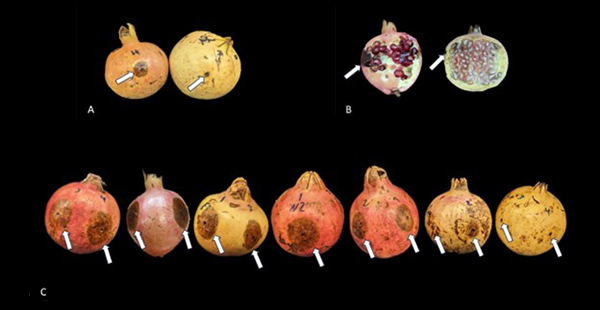Abstract
Pomegranate (Punica granatum L.) has primarily been cultivated at home in Florida and other southeastern states. Over the past 15 years, growers, nurseries, researchers, and Extension agents have explored the potential of pomegranate as an alternative fruit crop. Early field trials revealed that pomegranates are highly susceptible to Colletotrichum gloeosporioides, causing severe anthracnose fruit rot and premature fruit drop. The development and use of disease-resistant cultivars are considered some of the best methods to manage this disease. This publication presents our findings from evaluating 35 pomegranate cultivars under natural disease pressure in central Florida and by artificial inoculation. The susceptibility of such pomegranate cultivars varied widely, with six exhibiting resistance to anthracnose fruit rot. More comprehensive research is warranted to further develop anthracnose-resistant cultivars and to enhance our understanding of disease resistance in this crop.
References
Deng, Z., W. Castle, G. E. Vallad, S. Agehara, M. Thetford, and J. C. Díaz-Pérez. 2019. “Pomegranate: An Emerging Fruit Crop in Southeast United States?” ISHS Acta Horticulturae 1254: 149–156. https://doi.org/10.17660/ActaHortic.2019.1254.23.
LaRue, J. H. 1980. “Growing Pomegranates in California.” University of California Division of Agricultural Sciences, Leaflet 2459. Archived on April 3, 2014. https://web.archive.org/web/20140403201020/http://ucanr.edu/sites/Pomegranates/files/122804.pdf
Mangandi, J., N. A. Peres, and V. M. Whitaker. 2015. “Identifying Resistance to Crown Rot Caused by Colletotrichum Gloeosporioides in Strawberry.” Plant Disease 99 (7):954–961. https://doi.org/10.1094/PDIS-09-14-0907-RE
Phillips, D. A., P. F. Harmon, J. W. Olmstead, N. A. Peres, and P. R. Munoz. 2018. “Screening for Susceptibility to Anthracnose Stem Lesions in Southern Highbush Blueberry.” HortScience 53 (7): 920–924. https://doi.org/10.21273/HORTSCI12994-18
Schaller, A., J. M. Chater, G. E. Vallad, J. Moersfelder, C. Heinitz, and Z. Deng. 2023. “Pomegranate cultivars with diverse origins exhibit strong resistance to anthracnose fruit rot caused by Colletotrichum gloeosporioides, a major disease in southeast United States.” Horticulturae 9 (10): 1097. https://doi.org/10.3390/horticulturae9101097
Stover, E., and E. W. Mercure. 2007. “The Pomegranate: A New Look at the Fruit of Paradise.” HortScience 42 (5): 1088–1092. https://doi.org/10.21273/HORTSCI.42.5.1088
Xavier, K. V., A. N. KC, and G. E. Vallad. 2020. “Fungicide Application Timing Essential for the Management of Leaf Spot and Fruit Rot on Pomegranate (Punica granatum L.) in Florida.” Plant Disease 104 (6): 1629–1637. https://doi.org/10.1094/PDIS-10-19-2224-RE
Xavier, K. V., A. N. KC, and G. E. Vallad. 2019. “Diseases of Pomegranate (Punica granatum) in Florida: PP349, 10/2019.” EDIS 2019 (5): 5. https://doi.org/10.32473/edis-pp349-2019
Xavier, K., A. KC, N. A. Peres, Z. Deng, W. Castle, W. Lovett, and G. E. Vallad. 2019. “Characterization of Colletotrichum Species Causing Anthracnose of Pomegranate in the Southeastern United States.” Plant Disease 103 (11): 2771–2780. https://doi.org/10.1094/PDIS-03-19-0598-RE
Xavier, K. V., and G. E. Vallad. 2020. “Efficacy of Biological and Conventional Fungicide Programs for Foliar Disease Management on Pomegranate (Punica granatum) in Florida.” Plant Health Progress 21 (3): 199–204. https://doi.org/10.1094/PHP-02-20-0012-RS
Yu, X., K.V. Xavier, G. E. Vallad, and Z. Deng. 2018. “Disease Resistance in Pomegranates: Importance, Sources, Breeding Approaches, and Progress.” Proceedings of the Florida State Horticulture Society 131: 1–5. https://journals.flvc.org/fshs/article/view/114705/110032

This work is licensed under a Creative Commons Attribution-NonCommercial-NoDerivatives 4.0 International License.
Copyright (c) 2024 UF/IFAS

